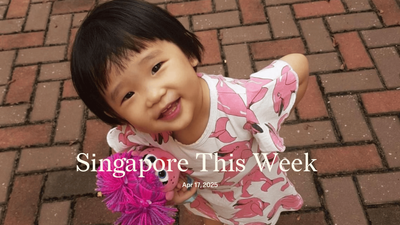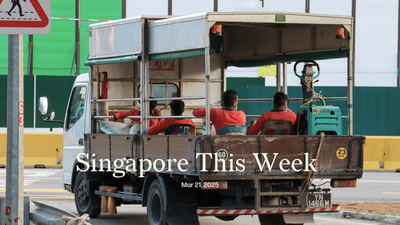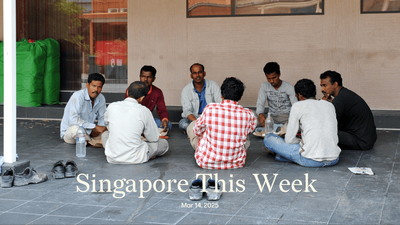Politics: Father knows best
In Parliament last week, Lee Hsien Loong, prime minister, gave a comprehensive and clear-eyed overview of the use of Singapore’s reserves—from the early days of the ruling People’s Action Party (PAP) and the advice he later sought from the Yale Investment Committee to its drawdown during the Covid-19 pandemic. He explained the evolution of the spending formula: 50 percent of the “net investment return contribution” (NIRC, which includes everything from dividends to capital gains) can be spent by the current government, and the other 50 percent saved. “There is no magic rule to this, but [in 2001] we arrived at a split of 50-50…50 per cent for the present, 50 per cent for the future.” Today, the NIRC accounts for 20 percent of government revenue—about equal to corporate tax revenues, 1.4 times personal income tax revenues, and 1.3 times goods and services tax (GST) revenues. The NIRC has remained stable at around 3.5 percent of GDP in recent years, suggesting that the reserves are growing broadly in line with the overall economy. Indranee Rajah, second minister for finance and national development, latched onto this point to refute opposition suggestions that the reserves are accumulating rapidly. She also reiterated the government’s longstanding objection to revealing its size (doing so will apparently make the Singapore dollar more vulnerable to currency speculators). She turned down a seemingly workable request by Gerald Giam of the Workers’ Party (WP) to disclose its size to the opposition in a cross-party select committee. The WP suggested that the formula be changed to 60-40, which would allow a larger share of the investment returns—while still preserving the principal—to be spent on Singaporeans today. It’s something that many on the left desire, to mitigate yawning social inequalities, particularly with poorer, elderly Singaporeans. In arguing against higher spending, Lee said: “But our forefathers who put aside the surpluses which grew into the reserves were much less well-off than us. To put it bluntly, much poorer than us.” With some PAP ministers living in mansions, the notion that ordinary Singaporeans should remember the 1960s and suck it up is one many may find off-putting. Lee also worried about having enough money in case we “find ourselves at war, like Ukraine”. But if there’s no minimum sufficient amount to the reserves, as he said, and also no magic to the “50-50” rule, who’s to say the current approach is the right one? Whatever the fever dreams of our military hawks, there is no Putin on our doorstep. Such bogeymen could distract us from the real challenge: the internal class conflict that’s brewing.
Politics: Are rich foreigners buying ‘scarce’ land and pricing out Singaporeans?
Singapore has just ranked third (after Switzerland and the US) in a global ranking of the best places for families to relocate to and build multi-generational wealth. This perhaps validates the decision by many plutocrats to set up family offices here, something that has accelerated in the wake of the pandemic. The PAP deserves credit for succeeding in its plan to turn Singapore into a global city beloved by the world’s rich. The flipside of this is the feeling by middle- and lower-income Singaporeans that it’s less and less a place for them. In a video this week, Chee Soon Juan, leader of the Singapore Democratic Party (SDP), sought to link property purchases by foreigners with broader inflationary pressures and societal issues. He cheekily quoted Inderjit Singh, a fiercely independent former PAP member of Parliament: “Singaporeans will be priced out of the private property market as we continue to see a flood of foreign funds flow into Singapore.” Some of the examples Chee highlighted are galling—in 2021, for instance, a single family from mainland China allegedly bought all 20 units of the luxury Eden condo for almost S$300m. He also noted the bungalows purchased in recent years by the founders of Haidilao, a food chain, and Grab. The existence of such grotesquely huge properties in Singapore, as was clear with the Ridout Road saga involving two PAP ministers last year, is something that bothers Singaporeans concerned with land distribution—many of whom are tired of the argument that forests must be destroyed for public housing because land is supposedly scarce. Of course, there are no easy answers to Singapore’s public housing conundrum, as Jom’s essay last week indicated. Moreover, it’s not clear if these inflows and their impacts on rent are necessarily “one of the major reasons why things are so expensive here”, as Chee claimed. But he did point out one of the main societal injustices concerning multi-generational wealth: owners of freehold properties will be able to pass on their land wealth to their kids, while owners of 99-year-leasehold properties will ultimately have to hand them back to the government (in return for nothing, mostly). “This wealth inheritance through property will lead to a fracturing of society,” Chee said. The PAP’s next leader, Lawrence Wong, clearly recognises the problem of wealth inequality, though the party’s attempts to reduce it may be insufficient for many, who’ll be eager to see the SDP’s policy alternatives. Chee will likely explore all this in his next book, It starts with a dream, which he’s launching at 3pm tomorrow, February 17th, at Orange & Teal in Rochester Mall.
Society: Press pause on cyberbullying
“This is supposed to be a fun game, why do people need to do bad things like this?” asked Nathan, a 13-year-old who regularly plays video games like “Minecraft” and “BombSquad”. Almost half of Singaporean children surveyed experienced in-game bullying—but only eight percent told their parents about it. This was one of the more worrying findings from the inaugural gaming survey (of 810 parent-child pairs) by the Ministry of Communications and Information (MCI). Other findings: nearly half of all respondents gamed for roughly two hours daily; a third of them would play with strangers online, with 14 percent of them sharing personal information with these strangers; and a quarter of all respondents with gaming time limits lie to their parents about their actual gaming time. “I do not game so I do not have a sense of [my daughter’s] experience,” said Josephine Teo, minister for communications and information, at a forum with parents, industry experts and online safety advocates in attendance. MCI’s survey results suggest that parents are largely unaware of their children’s online activities—only half of them could accurately estimate the amount of time their child spent online, and one quarter of parents were ignorant about who exactly their children were gaming with. The days of bulky Atari consoles and Game Boy cartridges are long gone; children can now engage in multiplayer online games and interact with strangers in chat boxes as soon as they receive their first internet-connected device, which happens at the average age of eight in Singapore compared to the global average of 10. This makes them vulnerable to a whole host of possible online harms, including cyberbullying (or becoming a cyberbully themselves) and exposure to explicit sexual or violent content. In order to address this information gap, MCI is rolling out some initiatives targeted at enhancing online safety, including “bite-sized materials” that inform parents on how to encourage their children to practise safe, appropriate online behaviour. While the aforementioned data points might scare some parents, there’s no need to ban your child from playing. In their survey, MCI also emphasised the potential benefits of gaming, highlighting other studies that found positive outcomes such as refined motor skills as well as enhanced creativity and imagination. By staying informed and promoting judgement-free, open and honest communication, parents can answer their “Call of Duty” and help their children navigate the world of online gaming.
Society: Speaking up about Gaza continues to be a delicate balancing act
Singaporeans have found ways to circumvent restrictions on free speech and assembly after authorities banned the holding of public events and assemblies in relation to the Israel-Hamas war, which the police determined could lead to “a real risk” of public disorder. Until now. Police are investigating two events that were held on February 2nd, which they have assessed to be of concern to public safety and security. “Anyhow waste our taxpayers’ money to harass us,” a local activist who participated in both events lamented to Jom. The first involved some 70 people walking peacefully to the Istana to deliver 140 letters to the prime minister. “Letters for Palestine: With Love From Singapore” rallied citizens to demand that their government, “cut ties” with Israel, “stop buying Israeli arms” and (ironically) “stop the police investigations into…people in Singapore…exercising their civil rights by peacefully expressing support for Palestinian lives, both online and offline…” According to the Singapore Police Force (SPF), several police reports were lodged against the “march”. SPF said that because these actions “advocate the political causes of other countries”, they have the “potential to stir up [racial] tensions and lead to public disorder.” It also noted that participants may have committed an offence by organising a public assembly without a permit. In truth, it looked more like a leisurely stroll with friends, all carrying matching umbrellas with watermelon motifs. The second gathering saw some 160 individuals converge at “Steadfast for Palestine”, a private, invitation-only event, which was live streamed on social media. In a statement responding to the investigations, organisers argued that rather than sow discord, “Steadfast…strengthened racial and religious solidarity and harmony in Singapore.” An opinion clearly not shared by everyone. “We must…not condone calls for violence,” the police advised, referring to the chanting of the phrase “from the river to the sea, Palestine will be free”, which it noted is associated with calls for the destruction of Israel. Organisers have refuted this, saying that it encapsulates Palestinians’ “desire for a free land where Muslims, Jews, Christians and people of all other faiths can live together peacefully as equals.” Sure, security is important. But clamping down on non-violent acts of solidarity quashes otherwise legitimate forums for public discourse, curtailing self-expression and potentially allowing feelings of despair, antipathy and frustration to fester. The Singapore Airshow, featuring Israeli defence companies, takes place later this month. Police have warned against protests. But everyday Singaporeans who “will not be silenced” will surely be weighing the pros and cons of defying these warnings. Perhaps it’s time authorities reopen Speakers’ Corner at Hong Lim Park—providing a “controlled” space to speak about Gaza, without fear of censure and arrest.
History weekly by Faris Joraimi
The Feast of Saint Valentine passed this Wednesday, and while celebrating love in ways platonic and romantic, I also thought of the day’s other crimes of passion. On February 14th 1779, the English “explorer” James Cook, whose voyages are commemorated as foundational events in the histories of Australia and New Zealand, was stabbed to death by the Hawaiʻian high chief Kanaʻina. Initially friendly relations soured after Cook’s crew disrespected Hawaiʻians and accused them of stealing one of their boats. Cook tried to kidnap the island’s ruler, Kalaniʻopuʻu, but thousands of Hawaiʻians surrounded him and his men; in the ensuing battle, Cook was killed. By then, however, this coloniser had written detailed accounts of his voyages, including a stopover at the great port of Batavia (modern-day Jakarta) where he famously described the “amock”, as in “running amok”, observed amongst the Malay-speaking people there. The Malay term amuk refers to a rampage, battle-frenzy, or violence rooted in grief. European observers saw it as a pathology specific to these tropical savages, who would—no matter how gentle and polite—be suddenly seized with a murderous rage, before snapping back into placid stupor (if they weren’t killed first). As Cook’s fatal end shows, “Native” anger wasn’t entirely baseless, and he himself records that most amuk cases involved slaves with few rights. Classified as a psychological disorder in 1849, amuk was thought to have been banished in Malaya by the early 20th century, thanks to British law. The word survived these racist implications, however. My childhood self associated it with parental anger, my mother warning me to behave before she goes amok (mengamuk). The other side of amuk, of course, is often love: above all amuk against unjust oppression, in solidarity with strangers. In one of his essays, the irreverent Salleh Ben Joned reminded us of their shared source: “remember too that the amok is not always a mad zombie who runs amok without any rhyme or reason. Don’t ignore your hati (heart) when it’s sakit (in pain). Don’t repress or betray the cry of your instincts, your body, your spirit.” Happy belated Valentine’s Day.
Arts: Shows for kids, and testbeds for artists making shows for kids
Get those fingers and toes working this weekend and the next with hand puppets and a ghost with dirty feet. Theatre companies The Finger Players and Teater Ekamatra are offering a Chinese-language workshop to acquaint kids with puppetry and a Malay-language stage adaptation of a children’s book in the flourishing field of theatre for young audiences, or TYA. Performances for kids have always been popular in Singapore, with pioneering companies such as ACT 3 Theatrics and ACT 3 International in existence since the 1980s. But more recent additions such as The Artground, the first multidisciplinary children’s arts centre in Singapore, have led to the exponential formalisation and professionalisation of the scene. For instance, practitioners now emphasise the need for performances that focus on narrower age ranges: say, shows for toddlers aged 18-24 months old instead of ones targetting children 3-12 years old. The latter will almost inevitably bore or elude some portion of that demographic because of their widely differing developmental milestones. There’s also been a push for more sensory-friendly and relaxed performances for very young children, or those who may not cope well with over-stimulation. Artists are now setting aside more time for work-in-progress showcases to test their shows with arguably the most candid of critics: you always know the moment you’ve lost, confused or terrified your young audience. If families don’t mind being part of the feedback loop, there is a regular rotation of free shows at The Artground by artists trying out new techniques and themes. This weekend, kids aged four and up can learn about conflict management and food waste, and those with infants in arms can take a ride on a magic sampan—the creators of this work say that dancing with your baby can provide vestibular stimulation and help with developing balance.
Arts: The ‘Singapore theatre’ saga continues
The Singapore Theatre Company (STC) has backpedalled on its name change after an outcry from local practitioners. The former Singapore Repertory Theatre dropped “repertory” from its name as part of a rebrand, but now says that it will be going through another round of consults before announcing its next new name in August. It acknowledged the polarising feedback the new title had drawn in an announcement on its website: “We believe a united community is necessary for the theatre scene to thrive and therefore will be changing our name from STC.”
Find out why STC changed its name in the first place here.
Tech: Singaporean chief scientist for US multilingual and multimodal language model
Reka, an artificial intelligence (AI) research and product company founded by ex-Google and Meta researchers, is attempting to take on Google and Microsoft with its own multimodal and multilingual language model. Its latest release, Reka Flash, has 21bn parameters—one of the largest publicly-disclosed models—and targets the likes of Google Bard and GPT-3.5, based on a competitive benchmark performance across over 30 languages. The introduction of Reka Edge also demonstrates an understanding of diverse deployment contexts beyond cloud environments. This balanced approach to both scale and flexibility could support a wide adoption of its products. Reka’s rapid progress has been fueled by its US$58m (S$78.2m) funding that exceeds what most start-ups receive. However, sustaining this trajectory and translating lab results to real-world impact will require ongoing validation. If Reka, whose chief scientist is Singaporean Yi Tay, delivers on its claims, it has the potential to disrupt the large language models (LLM) space. But establishing trust as a new player will take time. AI Singapore has also announced its own push towards developing an LLM for the South-east Asian region to address the complexity of a multilingual region that has varying cultural nuances. Large companies such as Tokopedia and NCS are currently piloting the use of its South-east Asian Languages in One Network model, also dubbed “SEA-LION”.
Tech: Universities driving rise of hardware innovation
While the rise of AI has created a second tailwind for software companies, hardware companies such as NVIDIA have also benefited tremendously from the spike in usage. Added to that is the increasing push for electrification of technologies such as electric vehicles (EV), resulting in the rise in hardware innovation in Singapore. Led by universities like the Nanyang Technological University (NTU), start-ups are commercialising transformative technologies. NTU’s efforts to incubate deeptech start-ups and to set up prototyping facilities are driving innovation that could transform the healthcare, energy sectors and more. The institution has developed patent-pending, ultra-thin, stretchable “soft electronics” that can conform to skin and monitor vital signs. To accelerate their development, NTU is opening a new pilot lab for industry collaboration. The lab will work with local small and medium-sized enterprises to rapidly prototype these electronic patches and sensors with applications in wearables and agriculture. In the energy sector, NTU-incubated Ampersand is industrialising solid-state transformer technology to enable more efficient EV charging and microgrids. The start-up recently raised US$12.4m (S$16.7m) in a seed round led by Xora Innovation, Temasek’s deeptech early-stage investment platform, to mass produce its systems. Built by ABB and GE veterans, Ampersand aims to address infrastructure needs through its modular, high-frequency transformers. With support from investors like Temasek and TDK, promising hardware companies like Ampersand are commercialising technologies to power the future. While recent announcements demonstrate Singapore’s push in the software domain, especially on AI, these developments exemplify the country’s continued commitment to growing its hardware prowess, especially through its universities.
If you enjoy Jom’s work, do get a paid subscription today to support independent journalism in Singapore.








